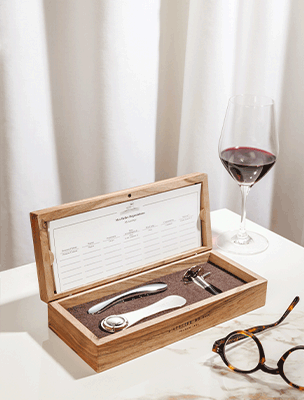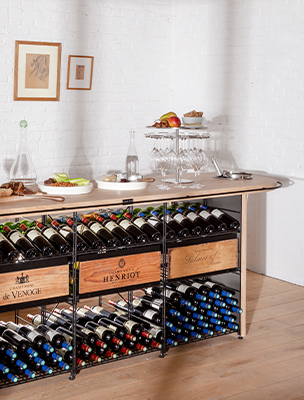JULY 06, 2021
WRITTEN BY CORAVIN
L’Atelier du Vin, French for “the wine workshop,” has been creating unique wine tools since the 1920s. Famously known for the Bilame, their tin-blade cork puller, L’Atelier du Vin makes a range of corkscrews and collectors sets that are available on the Coravin marketplace.
To learn more about L’Atelier du Vin, a family business with roots in the French wine-growing landscape, Coravin sat down with CEO Georges Richard. Watch our interview or scroll through the transcript below.
Lindsay Buck, Coravin: Today I’m talking with Georges Richard, CEO of L’Atelier du Vin, whose products we carry on the marketplace at Coravin.com. Welcome, Georges. How are you?
Georges Richard, L’Atelier du Vin: How are you doing? I am so happy being with you today.
LB: L’Atelier du Vin has a storied history. Can you tell me about the origins of the company?
GR: L’Atelier du Vin is the family business. It will turn 100 years 2026. We started in the world of wine in Champagne, where we still own vineyards and we are involved in taking care of vineyards and grapes. We don’t have a Champagne brand, but we do sell the grapes to major Champagne names.
LB: That’s very common in Champagne, right?
GR: Yes, exactly. It’s what we call cooperative.
LB: Awesome. So what makes the L’Atelier du Vin products unique?
GR: This is a good question, Lindsay. L’Atelier du Vin means “the wine workshop” in French – it’s a place where you think about the ways you will use tools and [where you put the tools to work]. For us, [ergonomics] are very important when you use a corkscrew, for example, or a decanter – the way you use it needs to make sense. We work for sometimes over a year on product development to make sure it’s the right tool and then comes the design in terms of color, materials, packaging – but, first and foremost, we try to design the right tool.
LB: Are the products still designed in Paris today?
GR: Yes, we have an internal studio based in Paris and our L’Atelier du Vin workshop – a small factory – is based in the north of France, near Amiens. That’s where we do all the prototypes, where we test all the products on numerous types of corkscrew.
LB: Which products do best in the American market?
GR: We can see that in other markets, but especially in US, we have a very specific line of corkscrew, Bilame, which is a very traditional old product created in 1947 (patented in 1949). All those [are selling well] in the US – they can come in different kinds of packaging, some tailored for gift giving and some more tailored for the products that you buy for yourself. Having said that, we are very happy that also in US all our gift sets [in wooden boxes sell well].
LB: Yes, we sell some of those gift sets on the marketplace. They’re beautiful – we’ve had so many nice comments about them. Have you ever made products that just didn’t work?
GR: Yes, Lindsay. We tried to come up with a new idea, which you can imagine is impossible to launch with so many products [out there]. So, we have had many fails – I can’t remember all of them. But, of course, we’ve been so excited to launch new products, and, at the end of the day, we can see that customers just don’t understand it. But we are lucky to say that, among all those fails, we have many more successes and that’s why L’Atelier du Vin is so strong today.
LB: That’s key, more successes than not successes. Our company mission at Coravin is to change the way the world experiences wine. Can you share a favorite wine experience that you’ve had?
GR: Well, my first memory would be back a long time ago – many decades ago – when we were doing by ourselves, making wine at home in Champagne. On weekdays and some nights, we were really putting all of our heart into making the wine. There’s also a memory I have from back when I was a student in my 20s. I was at Sacramento State University and I had the chance to travel, together with other students, to Napa almost every weekend to discover new wines and new ways of making wines. It’s among my most interesting memories regarding wine.
LB: That’s wonderful. So, how are we doing in California with our wine? Do you still enjoy any California wine today?
GR: Yes, of course. What I do is taste wine [from a different] region and area [almost] every trimester and it’s on my diary to come back to do tastings with the friends I was with during my studies in the next couple of months. So, I will for sure update you then.
LB: Oh, that’s great. Is there anything you’d like to plug or any exciting product developments on the horizon for L’Atelier?
GR: We are already finalizing the Christmas season. Christmas is very important for us and we try to put all that we have into product development for Christmas and into the gifting side of it. You can expect great and novel materials to be launched between April and September like true leather gift sets, among many other handmade products by artisans.
LB: I can’t wait to see them. You mentioned your father is he still very involved in the business?
GR: Yes, he is. He’s more like the R&D guy, you know. We are always calling him to ask him to come for a meeting, he will challenge our ideas. He will say, “Look, I would not do it that way, I would do it the other way.” And, by the way, he is very linked to the US as well since he did his studies at Harvard and my mother was at MIT. So, you see, we are very linked to your great country.
LB: You are very linked to where we are in Boston! I did not know that – that’s so interesting.
LB: And is it nice working with family overall?
GR: Oh, yes. We do enjoy it very much. It’s not easy on a daily basis, of course, we [strongly] try to push our own ideas. But, at the end of the day, it’s a good way to make things higher quality.




